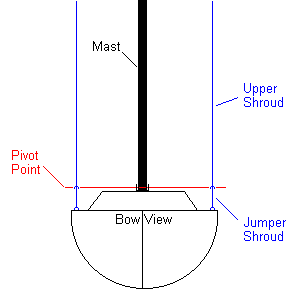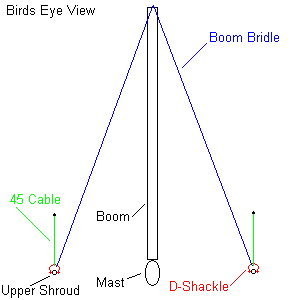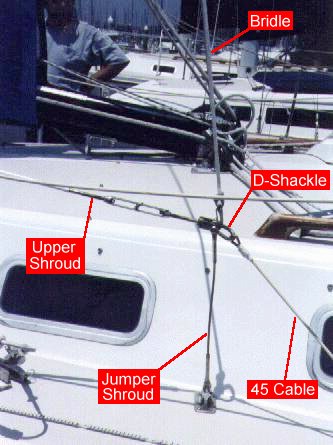
|
|
|
|
|
|
|
|
|
|
|
|
|
|
|
|
|
|
|
|
|
|
|
|
|
|
|
|
|
|
|
|
|
|
|
|
|
|
|
|
|
|
|
|
|
|
|
|

 Not Yet! - Mast Raising/Lowering
- Huntington Rig
Not Yet! - Mast Raising/Lowering
- Huntington RigThere are many ways to raise and lower a mast, but those sailors who need to do it often (getting under a low bridge to leave the marina), usually end up installing this style of rig. If you lower a mast without this type of rig, the shrouds will get very loose as you start to lower the mast down. You must keep the boat still and have someone at the mast to stabilize it. The advantage of the Huntington Rig is that you only need one person to easily lower or raise the mast, even under way, by using the mainsheet. Installing it is best left to professional riggers. This rig has different names in other areas, usually after a local low bridge.
 To lower the mast, remove the backstay (split backstay version only, standard is to long) and attach it to the end of the boom, or you can use a boom topping lift. Release the lower rear shrouds, attach a boom bridle and ease the mainsheet to lower. In this picture I have cleated off the mainsheet and stepped off the boat to take the picture. The mast is very stable in this position. My girlfriend is holding the tuff luff headfoil.
To lower the mast, remove the backstay (split backstay version only, standard is to long) and attach it to the end of the boom, or you can use a boom topping lift. Release the lower rear shrouds, attach a boom bridle and ease the mainsheet to lower. In this picture I have cleated off the mainsheet and stepped off the boat to take the picture. The mast is very stable in this position. My girlfriend is holding the tuff luff headfoil.
 To understand how it works, imagine extending the bolt that the mast pivots on, at the mast base, so that it extends out, and passes through each upper shroud (red pivot line in picture above). Now when you lower the mast the upper shrouds would stay taught because they would be attached to, and pivot on, the imaginary eight foot bolt, making it very stable. This is why the upper shroud is split into two pieces, creating a pivot point at the same level the mast pivots at.
To understand how it works, imagine extending the bolt that the mast pivots on, at the mast base, so that it extends out, and passes through each upper shroud (red pivot line in picture above). Now when you lower the mast the upper shrouds would stay taught because they would be attached to, and pivot on, the imaginary eight foot bolt, making it very stable. This is why the upper shroud is split into two pieces, creating a pivot point at the same level the mast pivots at.

 Notice in this picture a bridle has been added. The purpose of the bridle is to stabilize the boom, keeping it from falling to either side when the mast is lowered and the boom rises to vertical.
Notice in this picture a bridle has been added. The purpose of the bridle is to stabilize the boom, keeping it from falling to either side when the mast is lowered and the boom rises to vertical.


The bridle is attached to the tang at the end of the boom, where your mainsheet attaches, it extends to each upper/jumper shroud connection and attaches to the D-shackle. You can make the boom bridle out of rope with snap hooks at the three ends for fast attachment. Tie the snap hooks so that the bridle is somewhat taught, slack enough to easily attach and remove. Some use small lifeline cable for the bridle.
 In this picture the mast has been lowered and is resting on the bow pulpit. Notice how the upper shroud has pivoted at the connection to the jumper shroud. The boom bridle is now vertical, acting like a shroud to stabilize the boom, which is also vertical.
In this picture the mast has been lowered and is resting on the bow pulpit. Notice how the upper shroud has pivoted at the connection to the jumper shroud. The boom bridle is now vertical, acting like a shroud to stabilize the boom, which is also vertical.
Here are some helpful tips:
Quick release levers on the lower rear shrouds are worth the trouble to install them, you can quickly release the shroud tension, pull the pin, and release the shroud. I bought my pair at Boat/US.
Most likely you will need a new mainsheet. It takes a very long mainsheet to do the job with a 3 or 4 part purchase system. Make sure you calculate enough footage before you buy.
The swaged on end fittings on shrouds are the weak chain in the link. You might want to consider using stainless steel straps instead of a jumper shroud. They can be fabricated for much less money and would be much stronger if properly designed. Basically an extension of the chain plates.
If your upper shrouds are fairly new, you can have them cut at the appropriate place and new end fittings swaged on to make up both the upper and jumper shroud, saving a few bucks.
For extra security when raising and lowering, connect both the backstay and a boom topping lift to the end of the boom. Check the end boom fitting, the bolt for the tang and all the mainsheet attachment points often. If any of these fail, your mast and bow pulpit are history.
If you have the gooseneck fitting that slides in the mast slot, you'll need to put stoppers on both sides to keep the boom from sliding in the mast slot.
The rig is sturdy enough that you can cleat off the mainsheet and have the mast at any angle near the deck, without the need for someone to stabilize it. This allows you to do maintenance on the mast single handed. However for extra security tie a knot in the mainsheet right at the cam cleat so it can't slip through if the main should be accidentally jerked out of the cam cleat.

Most sailors radius the front edge of the base of the mast, so when the mast is lowered forward it will not bind on the square edge of the original base. This allow you to lower the mast without having to ease the upper shroud tension. If you are concerned that removing part of the mast will weaken it, or give the mast less of a foot to rest on, then you should know that people have been using the Huntington Rig for decades now, even on some big boats. Most radius the mast base and have never had problems.
Send comments or questions to: Jeff Pierce